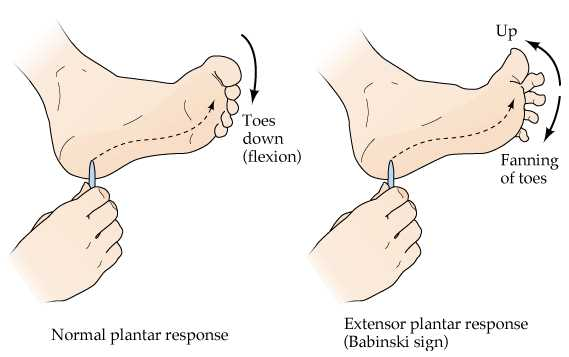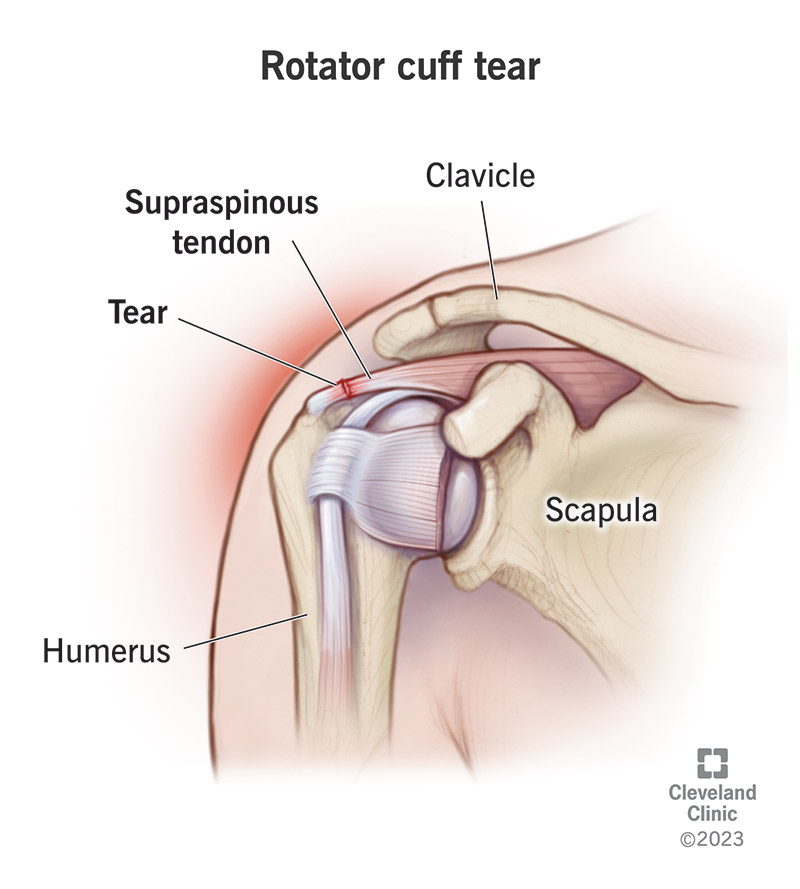A nurse is assessing the reflexes of a client who has an unrepaired femur fracture and has suddenly become stuporous. For which of the following findings should the nurse identify that the client exhibits Babinski's sign?
Dorsiflexion of the great toe
Pronation of the arms
Pinpoint pupils
Jerking contractions of the head and neck
The Correct Answer is A
Choice A reason:
Babinski's sign is a neurological reflex that's tested by stroking the sole of the foot. A positive Babinski's sign, which is normal in infants but abnormal in adults, is indicated by dorsiflexion of the great toe (the toe points up) while the other toes fan out. This reflex suggests dysfunction of the corticospinal tract, which may be due to various neurological conditions. In the context of a stuporous patient with an unrepaired femur fracture, a positive Babinski's sign could indicate an acute neurological change possibly related to the injury or a secondary complication such as a fat embolism syndrome, which can occur after fractures and may affect the brain.
Choice B reason:
Pronation of the arms is not associated with Babinski's sign. Pronation is a rotational movement where the hand and upper arm are turned inwards. While arm movements are part of the neurological examination, they do not constitute a response to the plantar reflex test used to elicit Babinski's sign.
Choice C reason:
Pinpoint pupils may indicate opioid overdose or damage to the pons due to various causes, but they are not a component of Babinski's sign. Pupil size and reaction to light are important in neurological assessments, but they are separate from the reflexes tested by the Babinski sign.
Choice D reason:
Jerking contractions of the head and neck are not related to Babinski's sign. These could be indicative of seizure activity or other neurological disorders but are not a response to the plantar reflex test.

Nursing Test Bank
Naxlex Comprehensive Predictor Exams
Related Questions
Correct Answer is A
Explanation
Choice A reason:
The inability to abduct the arm at the shoulder is a classic sign of a rotator cuff injury. The rotator cuff is responsible for stabilizing the shoulder joint and aiding in various movements, including abduction. When there is a tear or significant weakness in the rotator cuff muscles, especially the supraspinatus muscle, the patient may be unable to lift the arm away from the body or may experience pain while doing so.
Choice B reason:
A negative drop arm test would actually indicate that there is no rotator cuff injury. The drop arm test is performed by asking the patient to fully abduct the arm to 90 degrees and then slowly lower it. If the patient can control the motion and lower the arm smoothly, the test is negative. A positive drop arm test, where the patient cannot control the descent of the arm, would suggest a rotator cuff tear.
Choice C reason:
While an alteration in the contour of the joint may indicate some form of shoulder pathology, it is not specific to a rotator cuff injury. Changes in the contour could be due to various conditions, including dislocation, arthritis, or other musculoskeletal disorders.
Choice D reason:
A positive Tinel's sign is used to diagnose nerve compression or nerve damage, not rotator cuff injuries. It is performed by tapping over the course of a nerve to elicit a tingling sensation or pain in the distribution of the nerve. This sign is commonly associated with conditions like carpal tunnel syndrome.

Correct Answer is D
Explanation
Choice A reason:
Urine-specific gravity measures the concentration of urine compared to water. It can indicate various conditions affecting the kidneys, but it does not provide a direct measure of renal function. It can be affected by hydration status and does not specifically reflect kidney damage or disease.
Choice B reason:
Blood urea nitrogen (BUN) levels can indicate kidney health; however, BUN can also be influenced by factors such as protein intake, hydration, and liver function. Therefore, while it is a useful test, it is not the most specific indicator of renal function in isolation.
Choice C reason:
Serum sodium levels are important for assessing electrolyte balance and can be affected by kidney function. However, changes in serum sodium are not specific to kidney function alone and can result from a variety of conditions.
Choice D reason:
Serum creatinine is a waste product from the normal breakdown of muscle tissue. As the kidneys are responsible for filtering out creatinine, its level in the blood is a good indication of kidney function. Elevated levels of serum creatinine may indicate impaired kidney function or kidney disease. In the context of SLE, where kidney involvement is common, serum creatinine is a crucial marker for monitoring renal function.
Whether you are a student looking to ace your exams or a practicing nurse seeking to enhance your expertise , our nursing education contents will empower you with the confidence and competence to make a difference in the lives of patients and become a respected leader in the healthcare field.
Visit Naxlex, invest in your future and unlock endless possibilities with our unparalleled nursing education contents today
Report Wrong Answer on the Current Question
Do you disagree with the answer? If yes, what is your expected answer? Explain.
Kindly be descriptive with the issue you are facing.
